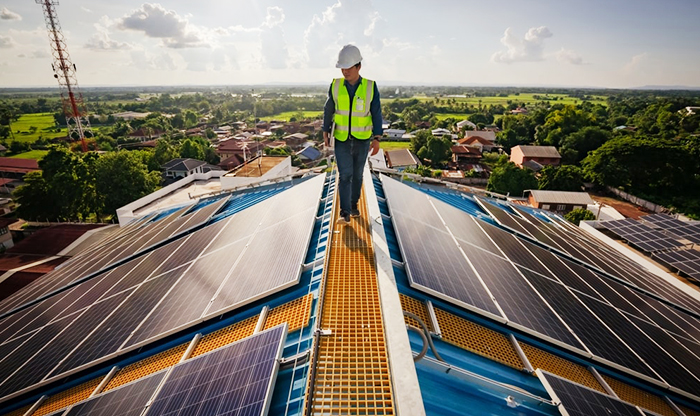Walkways are essential components in solar panel installations, especially for commercial and large-scale projects. With the increasing adoption of solar energy worldwide, ensuring the safety, accessibility, and efficiency of solar panel maintenance and monitoring is critical. In this blog, we’ll explore the importance of walkways for solar panel installations, focusing on their benefits, materials, installation tips, and safety considerations.
In large-scale solar panel installations, access to the panels for maintenance and inspection is crucial. Walkways provide a safe and convenient path for technicians and maintenance crews to access the solar arrays, particularly in rooftop installations or ground-mounted solar farms. They help minimize the risk of accidents, protect the integrity of the panels, and ensure smooth operational performance.
Here are some reasons why walkways are essential in solar installations:
Safety First: Walkways prevent accidental falls or damage to the solar panels. Workers can move safely between panels without stepping on sensitive areas, preventing damage to the panels, wiring, or other infrastructure.
Efficiency in Maintenance: Walkways provide easy access for cleaning, troubleshooting, and repairing solar panels. The walkways ensure that workers don’t waste time navigating through difficult terrain or creating new paths that could damage the site.
Long-Term Panel Protection: By directing foot traffic along designated paths, walkways help avoid unnecessary stress on the solar panels. This is particularly important in delicate rooftop installations, where walking directly on the panels can lead to potential issues with mounting structures.
Compliance with Regulations: Many solar panel installations are subject to building codes and regulations, which include safety provisions for rooftop access. Installing walkways ensures compliance with these safety standards, reducing liability and risk for installation companies.

There are various materials and systems available for walkway construction. Choosing the right type of walkway depends on the specifics of your solar project, including the roof type, panel layout, and maintenance frequency. Here are the most common walkway options:
Material: Fiberglass-reinforced plastic (FRP) or steel.
Benefits: Highly durable, anti-slip properties, lightweight, and resistant to corrosion. FRP walkways are particularly popular for rooftop installations due to their weather-resistant qualities.
Ideal For: Rooftop solar panel systems in commercial and industrial buildings.
Aluminum Walkways:
Material: Lightweight and corrosion-resistant.
Benefits: Aluminum walkways are designed for easy installation and high durability. They offer strong support while maintaining a lightweight structure.
Ideal For: Both rooftop and ground-mounted solar panel installations, offering flexibility for various projects.
Rubberized Walkways:
Material: Rubber or PVC mats.
Benefits: Easy to install and flexible, rubberized walkways provide a cushioned and safe pathway for workers to walk on. They help protect both the workers and the solar panels.
Ideal For: Rooftop installations where added protection and comfort are necessary for workers.
Modular Walkway Systems:
Material: Interlocking panels made of metal, plastic, or composite materials.
Benefits: Modular systems are flexible and customizable to fit any roof size. They can be easily adapted and moved for different configurations or re-installations.
Ideal For: Large commercial solar farms or installations where frequent changes in panel configuration may be necessary.
Durability: Solar panel installations are designed for long-term performance, so the materials used in walkways should also be durable and resistant to weather conditions. Materials like fiberglass, aluminum, and steel are often preferred due to their ability to withstand harsh environments.
Non-Slip Surface: Safety is a top priority when selecting walkway materials. Make sure the walkway has a non-slip surface, especially for installations exposed to rain or snow. Walkway grating or textured surfaces can help prevent accidents during maintenance work.
Weight Capacity: Consider the weight capacity of the walkway system, particularly if heavy equipment or maintenance tools will be transported across the roof. Ensure the walkway system is strong enough to bear the load without bending or breaking.
Ease of Installation: Walkways should be easy to install and integrate with the solar panel system. Modular systems or prefabricated components can significantly reduce installation time and cost.
Cost: Walkways come in various price ranges depending on the material and design. While fiberglass and aluminum tend to be more affordable, other materials like steel and stainless steel may offer longer-lasting solutions for heavy-duty applications.
Plan the Layout: Before installation, plan the layout of the walkway to ensure safe access to all necessary panels. Walkways should run along the edges of the panels or in between rows for easy access to every panel.
Ensure Proper Alignment: When installing the walkway, make sure it aligns with the panels and roof structure to avoid damage. It’s important that the walkway doesn’t interfere with the airflow around the panels, as this can impact their performance.
Use Non-Invasive Installation Methods: For rooftop installations, ensure that the walkway system doesn’t require penetration of the roof or cause damage to the existing waterproofing. Many modern walkway systems are designed to be installed without the need for drilling or invasive methods.
Provide Proper Maintenance: Regularly check the walkway for any signs of wear or damage, and perform routine cleaning to maintain safety. This will help extend the lifespan of the walkway and keep it functional over time.
Investing in a high-quality walkway system for your solar panel installation ensures that both the panels and maintenance personnel are well-protected. By offering safe and efficient access, walkways help preserve the longevity and performance of your solar system, while also providing peace of mind for workers. Whether for rooftop or ground-mounted solar installations, there are various options to fit the unique needs of your solar project.

 Xiamen TopFence Co.,Ltd.
Xiamen TopFence Co.,Ltd. No. 77, LingXia South Road, Huli District, Xiamen City, Fujian, China
No. 77, LingXia South Road, Huli District, Xiamen City, Fujian, China Tel: +8613365923720
Tel: +8613365923720
 Email: info@xmtopfence.com
Email: info@xmtopfence.com
 IPv6 network supported Sitemap
| XML
| Blog
| Privacy Policy
IPv6 network supported Sitemap
| XML
| Blog
| Privacy Policy


